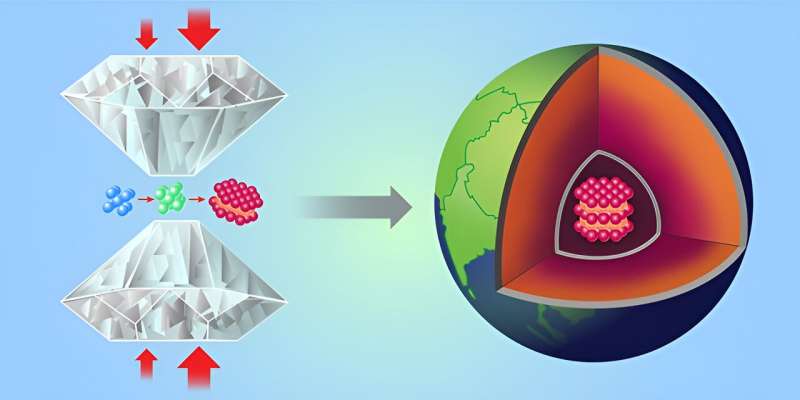Physicists synthesize single-crystalline iron in the form likely found in Earth's core

A team of physicists and geologists at CEA DAM-DIF and Universit´e Paris-Saclay, working with a colleague from ESRF, BP220, F-38043 Grenoble Cedex and another from the European Synchrotron Radiation Facility, has succeeded in synthesizing a single-crystalline iron in a form that iron has in the Earth's core.
In their paper published in the journal Physical Review Letters, the group describes how they used an experimental approach to synthesize pure single-crystalline ε-iron and possible uses for the material
In trying to understand Earth's internal composition, scientists have had to rely mostly on seismological data. Such studies have led scientists to believe that the core is solid and that it is surrounded by liquid. But questions have remained. For example, back in the 1980s, studies revealed that seismic waves travel faster through the Earth when traveling pole to pole versed equator to equator, and no one could explain why.
Most theories have suggested it is likely because of the way the iron in the core is structured. Most in the field agree that if the type of iron that exists in the core could be made and tested at the surface, such questions could be answered with a reasonable degree of certainty. But doing so has proven to be challenging due to fracturing during synthesis. In this new effort, the research team has found a way around such problems and in so doing have found a way to synthesize a type of iron that can be used for testing the properties of iron in Earth's core.
The work by the team involved compressing a sample of α-iron at 7GPa. Doing so caused its temperature to rise to approximately 800 Kelvin. That led to the transformation of its structure into γ-iron crystals. More pressure pushed the γ-iron to form into ε-structure iron—single crystals that are believed to be the same types as those in the iron at Earth's core.
The research team conducted experiments that showed the directionally-dependent elasticity of their ε-iron behaving as iron does in the Earth's core, with vibrations traveled faster along one axis of a sphere than along the other. They suggest their approach can be used for generating iron samples for testing theories regarding the makeup of Earth's core.
More information: Agnès Dewaele et al, Synthesis of Single Crystals of ε -Iron and Direct Measurements of Its Elastic Constants, Physical Review Letters (2023). DOI: 10.1103/PhysRevLett.131.034101
Journal information: Physical Review Letters
© 2023 Science X Network
Reproducing core conditions suggests Earth's outer core less dense than liquid iron
No comments:
Post a Comment